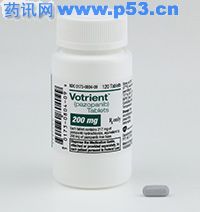制造商:
葛兰素史克制药
药理分类:
激酶抑制剂
活性成分(补):
帕唑帕尼200毫克,400毫克;标签
指示(补):
晚期肾细胞癌。
药理作用:
帕唑帕尼是一种血管内皮生长因子受体(VEGFR)-1,VEGFR - 2的,VEGFR - 3的,血小板衍生生长因子受体-α和-β,成纤维细胞生长因子受体-1和-3多激酶抑制剂,细胞因子受体,白细胞介素-2受体诱导T细胞激酶,白细胞特异性蛋白酪氨酸激酶和跨膜糖蛋白受体酪氨酸激酶。
临床试验:
帕唑帕尼进行了评估,安慰剂控制的第三期涉及435例肾细胞癌患者的研究。患者被随机(2:1)接受800毫克或安慰剂帕唑帕尼每日一次。在这个试验中,整体无进展生存期(PFS)为9.2和4.2个月,帕唑帕尼与安慰剂个月。治疗初治患者谁收到帕唑帕尼经验的中位PFS 11.1个月比2.8个月的安慰剂。此外,谁曾收到细胞因子为基础的治疗的患者取得了帕唑帕尼与安慰剂组为4.2个月,中位PFS 7.4个月。
法律分类:
接收
成人:
就以一个空的胃。燕子的整体。 800毫克,每日一次。肝功能不全:中度:每天一次200毫克,严重:不推荐。伴随强效CYP3A4抑制剂(如酮康唑,利托那韦,克拉霉素):避免,如果需要的话,减少帕唑帕尼400毫克剂量,可能进一步减少,如果中毒发生。伴随强CYP3A4的诱导剂(如利福平):避免。
儿童:
不推荐。
警告/注意事项:
开始前,至少监测肝,每4周检查一次,至少在头4个月的治疗,然后定期。如果之间3xULN和8xULN ALT键ALT键继续进行,直至恢复到1级或每周监测基准与治疗。如果ALT键> 8xULN ALT键,直到返回到1级或基线中断治疗;可能考虑重新采用减少剂量,测量肝测试8周每周一次,如果ALT键> 3xULN复发,永久停止。如果ALT键永久终止> 3xULN和胆红素> 2xULN。吉尔伯特综合征(见文献)。历史的QT间期延长。心脏疾病。监测心电图,电解质(如钙,镁,钾),甲状腺,尿液分析。咯血,脑,消化道出血或有临床意义的历史,在过去6个月:不推荐。动脉血栓事件(在过去6个月:不推荐)的风险。如果停止严重和持续的高血压(尽管降压治疗和减少剂量)或4级蛋白尿发生。停止治疗手术前至少7天,停止与伤口裂开患者。妊娠(Cat.D),哺乳期妇女:不推荐。
互动(补):
见成人剂量:CYP3A4的强抑制剂Potentiated,西柚汁。 CYP3A4的诱导剂强对抗。不推荐:与被CYP3A4,CYP2D6的,或CYP2C8代谢治疗窗窄的药物同时服用。注意伴QT间期延长的药物(如抗心律失常药)。
不良反应(补):
腹泻,高血压,头发的颜色变化,恶心,厌食,呕吐,肝(可能是严重的或致命的),QT间期延长,出血性事件,动脉血栓事件(如心肌梗塞,心绞痛,缺血性中风,TIA),胃肠穿孔或瘘管,受损的伤口愈合,甲状腺功能减退,蛋白尿。
如何提供:
制表符为200mg - 30,90,120
为400mg - 30,60
最后更新:
2010年2月3日
VOTRIENT
Manufacturer:
GlaxoSmithKline Pharmaceuticals
Pharmacological Class:
Kinase inhibitor
Active Ingredient(s):
Pazopanib 200mg, 400mg; tabs.
Indication(s):
Advanced renal cell carcinoma.
Pharmacology:
Pazopanib is a multi-kinase inhibitor of vascular endothelial growth factor receptor (VEGFR)-1, VEGFR-2, VEGFR-3, platelet-derived growth factor receptor-α and-β, fibroblast growth factor receptor-1, and -3, cytokine receptor, interleukin-2 receptor inducible T-cell kinase, leukocyte-specific protein tyrosine kinase, and transmembrane glycoprotein receptor tyrosine kinase.
Clinical Trials:
Pazopanib was evaluated in a placebo-controlled Phase 3 study involving 435 patients with renal cell carcinoma. Patients were randomized (2:1) to receive pazopanib 800mg or placebo once daily. In this trial, the overall median progression free survival (PFS) was 9.2 months with pazopanib and 4.2 months with placebo. Treatment-naive patients who received pazopanib experienced 11.1 months of median PFS vs 2.8 months with placebo. Additionally, patients who had previously received cytokine-based treatment achieved 7.4 months of median PFS with pazopanib vs 4.2 months with placebo.
Legal Classification:
Rx
Adults:
Take on an empty stomach. Swallow whole. 800mg once daily. Hepatic impairment: moderate: 200mg once daily; severe: not recommended. Concomitant strong CYP3A4 inhibitors (eg, ketoconazole, ritonavir, clarithromycin): avoid; if warranted, reduce dose of pazopanib to 400mg; may reduce further if toxicity occurs. Concomitant strong CYP3A4 inducers (eg, rifampin): avoid.
Children:
Not recommended.
Warnings/Precautions:
Monitor liver tests before starting and at least once every 4 weeks for at least the first 4 months of treatment, then periodically. If ALT between 3xULN and 8xULN continue therapy with weekly monitoring until ALT returns to Grade 1 or baseline. If ALT >8xULN interrupt therapy until ALT returns to Grade 1 or baseline; may consider reintroducing at a reduced dose, measure liver tests weekly for 8 weeks; if ALT>3xULN recurs, permanently discontinue. Permanently discontinue if ALT>3xULN and bilirubin >2xULN. Gilbert’s syndrome (see literature). History of QT prolongation. Cardiac disease. Monitor ECG, electrolytes (eg, calcium, magnesium, potassium), thyroid, urinalysis. History of hemoptysis, cerebral, or clinically significant GI hemorrhage in the past 6 months: not recommended. Risk of arterial thrombotic events (within previous 6 months: not recommended). Discontinue if severe and persistent hypertension (despite antihypertensive therapy and dose reduction) or if Grade 4 proteinuria occurs. Stop therapy at least 7 days before surgery; discontinue in patients with wound dehiscence. Pregnancy (Cat.D), nursing mothers: not recommended.
Interaction(s):
See Adult dosing: Potentiated by strong CYP3A4 inhibitors, grapefruit juice. Antagonized by strong CYP3A4 inducers. Concomitant drugs with narrow therapeutic windows metabolized by CYP3A4, CYP2D6, or CYP2C8: not recommended. Caution with concomitant drugs that prolong QT interval (eg, antiarrhythmics).
Adverse Reaction(s):
Diarrhea, hypertension, hair color changes, nausea, anorexia, vomiting; hepatotoxicity (may be severe or fatal), QT prolongation, hemorrhagic events, arterial thrombotic events (eg, MI, angina, ischemic stroke, TIA), GI perforation or fistula, impaired wound healing, hypothyroidism, proteinuria.
How Supplied:
Tabs 200mg—30, 90, 120
400mg—30, 60


